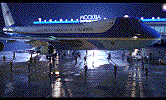
Directed by Wolfgang Petersen
Visual Effects Supervisor Richard Edlund

Directed by Wolfgang Petersen
Visual Effects Supervisor Richard Edlund
CINESITE
DIGISCOPE
Nominated for one 1997 VFX HQ Awards: Best Invisible Effects (Russian Airport).
Harrison Ford stars as the President of the
United States in this thriller, which also stars Gary Oldman as the leader of a terrorist group that hijack's the President's plane. The film features visual effects by Boss Film Studios and Cinesite that depict the highly complicated situations involving the 747.
Boss Film handled many of the film's early sequences, including the introductory flying shots of AFO. A model miniature of AFO was created in Boss' model shop, as well as a computer generated model of the plane. Depending on the trajectory of the plane in a certain shot, the decision was made to use either the real-life model (shot on a motion control stage) or the CG model (animated and rendered within a computer). The CG model was so accurate and realistic, that it was used in some closeup shots of AFO--shots that would usually have to be completed with the real-life model miniature.
 Visual Effects Produced by:
Visual Effects Produced by:
BOSS FILM STUDIOS
Supervisor: James E. Price
Co-Supervisor: David M. Jones
Supervisor: Brad Kuehn
Producer: Scott Dougherty

Boss Film Studios created the Russian Airport terminal from which the President departs into Air Force One. The matte painting was based on various photographs and was perfectly tracked into frame. The shot was composited by Digiscope. |
As good as the models were created, there exist some problems with how they were placed within a shot. Although much of the match-moving was consistent, a few shots of AFO zooming past the camera suffered from from 'sliding'--since the plane and the background are separate elements, extreme care on the visual effects team's part must be taken so that the perspective angles match between the foreground and the background. This is especially difficult with moving camera shots, and in a few, the plane's path didn't exactly match the background plate.
A more looming complaint of the nighttime aerial visual effects sequences from AIR FORCE ONE is the lack of organic camera shake and drift. In a real situation, plane-to-plane photography is frenetic and unpredictable. The camera plane is flying at hundreds of miles per hour, the focus plane is moving at hundreds of miles per hour, and the camera operator must compensate for all of this--to keep the plane in frame, he or she must make constant adjustments in pan and tilt. Audiences have seen countless airplane documentaries, and have become accustomed to the way true aerial photography looks and feels.
The added sense of realism that comes with subtle camera shakes and pan/tilt adjustments are missing from the aerial sequences in AFO. In one instance, the camera doesn't follow the action--it almost leads it. An F-15 fires upon AFO, and the camera perfectly tracks the missile's path. The missile remains in the same part of the frame during its entire flight path. This particular shot screams out at the audience, "THIS IS AN EFFECTS SHOT!", since it is obvious that the 'camera operator' knew exactly when the missile would be fired, and knew its precise velocity and speed.
There are plenty of wonderful effects shots in AFO--particularly fantastic is the conclusion of the sequence where the refueling plane blows up over AFO. In a shot that is probably the film's finest effects shot, AFO's belly flies over the camera while the other plane erupts in a firey blast. The camera remained still, and the interaction between the flames and AFO truly made it seem like this effects occurred in-camera, right in front of our eyes. The great sequence continues with some terrific greenscreen composites of Harrison Ford clinging to AFO as the refueling plane explodes behind him.
Another memorable sequence occurs as AFO crashes into the sea. In this ambitious sequence, the plane's animation is quite naturalistic and believable, and the matchmoving and compositing are crisp. However, the interaction between the water and the plane leave a lot to be desired. Also, the camera appeared in a wholly unsuitable location for the sequence's last shot--directly in the path of AFO, destroying the illusion.
The film's last half hour contains dozens upon dozens of greenscreen composites. The best sequence of greenscreen compositing occurs as Ford and Oldman have a fistfight at the back of AFO, with its main cargo bay open. No matter where the camera went in this sequence, the clouds and sky element remained consistent and believable.
The daylight-based air-to-air transfer sequences required many dozens of composites, once again, and most were accomplished with fine results. Problems inherent to the greenscreen compositing process include the lack of blur between a quick-moving foreground element and the newly composited background. This non-naturalistic phenomenon becomes quite apparent after a few dozen shots in a row. Also, the sometimes rigid camera positions and its lack of movement suggests illusion over reality.
Besides these problems, AIR FORCE ONE is a joyously entertaining film with some strong visual effects. The best effects from the film look realistic and contain wonderful animation and compositing, while the worst suffer from concept-based (not animation or compositing based) problems, including the lack of camera shake and unrealistic camera movement.
Check out American Cinematographer July '97.
Official Web Site: http://www.spe.sony.com/Pictures/SonyMovies/movies/AFO/

. . VFX HQ Produced by Todd Vaziri . . http://www.vfxhq.com . . e-mail: tvaziri@gmail.com . .
All text Copyright © 1998 Todd Vaziri, unless otherwise noted